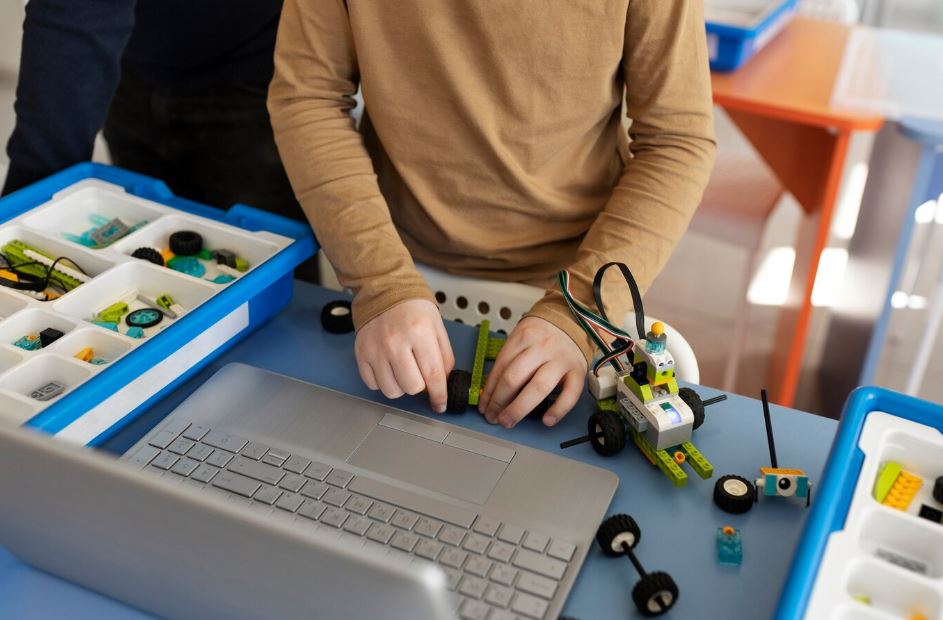
Projects involving creative computing have changed how young students use technology during the last ten years. These projects, which combine coding and creativity, use tools like Scratch and Chrome Music Lab to empower students to become producers rather than consumers. With just dragging blocks of code, students can create interactive experiences, games, and animated stories using Scratch, which was created at MIT and is utilized by Harvard’s Creative Computing Lab.
These initiatives foster an atmosphere where learning is more akin to creating by empowering students to express themselves digitally. One notable example is the Scratch digital storytelling project, where students create animated scenes, add voiceovers, and give life to characters—leading them through an enjoyable and incredibly instructive process. Like professional developers, they experiment, remix, and iterate instead of learning commands by heart.
Creative Computing Projects Overview
| Key Element | Description |
|---|---|
| Main Focus | Combining technology with creativity through digital projects |
| Popular Tools | Scratch, Chrome Music Lab, Google Sites, Google Forms |
| Key Audiences | KS2 learners, secondary students, educators, creative technologists |
| Leading Institutions | Harvard GSE, UAL Creative Computing Institute, Brunel University |
| Key Collaborators | Google, SONY, Microsoft, Royal College of Music |
| Featured Projects | AI-generated music, digital storytelling, virtual tours, accessibility tools |
| Major Outcomes | Computational thinking, creative problem-solving, social inclusion |
| Teaching Value | Hands-on learning, collaboration, innovation |
| Societal Benefits | Inclusion for disabilities, democratized digital access, tech literacy |
These days, creative computing projects go far beyond the fundamentals taught in the classroom. The London-based Creative Computing Institute collaborates with businesses such as Google and Sony to create platforms that investigate AI-powered sound design, generative art, and VR-based accessibility tools. These initiatives, which use machine learning to provide personalized, responsive experiences, are especially helpful for autistic children and those enrolled in rehabilitation programs.
One creative computing project at the Barbican Centre’s “AI: More Than Human” exhibition enthralled viewers by using artificial intelligence to remix Massive Attack’s Mezzanine album in real time. Under the direction of Professor Mick Grierson, this project is a brilliant illustration of how music and machine learning can combine to create technologically advanced, emotionally impactful experiences. Visitors were more than just listeners; they were also involved in using AI to shape sound.
Google Sites and other student-focused platforms have evolved into the standard tools for creating digital portfolios. Without requiring any prior knowledge of coding, these sites enable students to curate their work, reflect on their learning, and gain digital fluency. Particularly for schools with tight tech budgets, the process becomes surprisingly affordable with drag-and-drop tools and customizable themes.
Chrome Music Lab is still a very flexible tool for exploring music in the interim. Students can use a grid of colors and sounds to create beats and melodies with its Song Maker module. Other modules, such as Kandinsky, combine visual and aural creativity to create music from drawings, making learning remarkably captivating. Even students without any musical experience feel comfortable and eager to share their compositions, according to teachers.
Google Forms’ interactive quizzes are disguised as creative computing experiences for younger students. By adding pictures, videos, and even embedded feedback, students can create their own quizzes. They acquire research techniques, study user experience, and develop critical thinking skills related to clear communication of information. It is a very clear process that is also sufficiently difficult to test cognitive abilities.
The Google Slides stop-motion animation project is equally creative. To simulate real movement, students time their slide transitions, create a storyboard, and take sequential pictures. Sequencing, visual storytelling, and teamwork are all taught using this low-tech, high-creativity method. These are not only instructive but also highly transferable skills.
By incorporating these strategies, educational institutions cultivate an innovative culture. Teachers stop being instructors and start acting more like guides. Classrooms become miniature art studios. Students are using technology to learn rather than just learning it.
The need for inclusivity is increasingly driving creative computing initiatives across research institutions. With the help of initiatives like Project Tokyo, a partnership with Microsoft Research, visually impaired students can now use real-time AI to better interpret their environment. By identifying people and objects in space, the tool converts them into audio cues that facilitate safer and easier navigation.
The HEartS Professional project, created in collaboration with Imperial College and the Royal College of Music, investigates the use of virtual reality and mixed reality in live music performances. For artists who are physically confined or have disabilities, this is especially inventive. These tools are deeply expressive in addition to being useful.
The Wellcome Hub’s digital citizenship project is among the most emotionally charged examples. The project challenges public perceptions of autism and learning disabilities by utilizing big data in collaboration with the disability arts organization Heart n Soul. It serves as an urgent reminder that computing involves empathy and change in addition to logic and code.
The curriculum for creative computing is intended to be collaborative, open-ended, and iterative from an educational perspective. Students use storytelling, animation, and even interactive art installations to investigate computational ideas like loops, conditionals, and data structures. Because of its great efficiency, this structure keeps students deeply engaged while enabling teachers to adapt lessons to a range of ages and skill levels.
These initiatives use participatory design and real-time interaction to humanize technology. Along with technical skills, students also acquire a fresh perspective on creativity. They combine math, logic, design, storytelling, and empathy when creating a game or VR tour—skills that are reflected in the most cutting-edge businesses of today.
These initiatives will continue to develop in the upcoming years as artificial intelligence is incorporated more deeply into artistic tools. Adaptive games and customized learning environments are already possible thanks to tools like InteractML that make it simpler to integrate machine learning into Unity. The integration, which is supported by an EPIC MegaGrant from Epic Games, aims to make AI-based design accessible to both independent developers and students.
